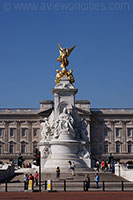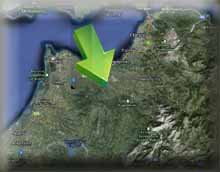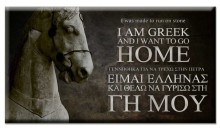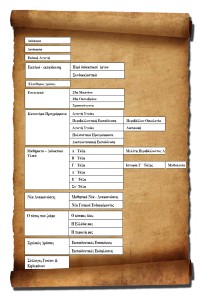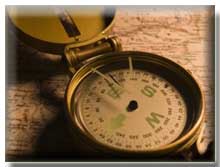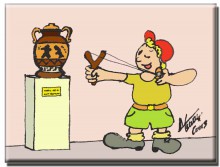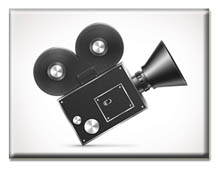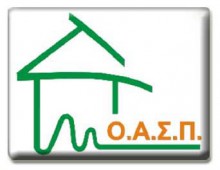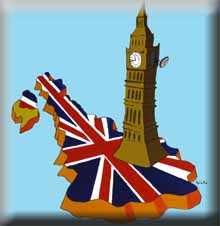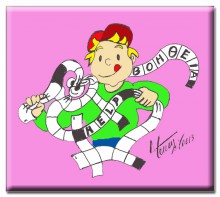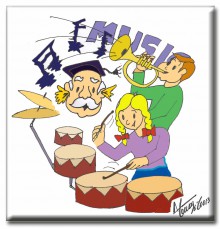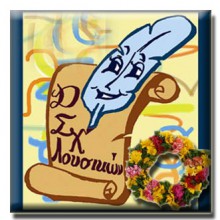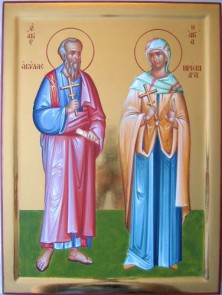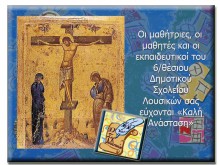Some of the top atractions in London that English Language Students should be aware of are the following:
The Big Ben, the London Eye, the Tower Bridge, the Buckingham Palace, the Tower of London, Trafalgar Square, Hyde Park and the British Museum.
Let’s read some interesting information about them. 🙂
Source of information: http://www.aviewoncities.com/london.htm
The BIG BEN
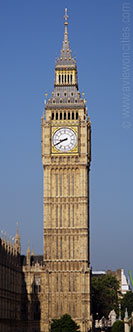
Big Ben
There were two bells cast as the clock tower’s hour bell. A first, 16 ton weighing bell was cast by John Warner and Sons in 1856. Since the Clock Tower was not yet completed, the bell was hung temporarily in the Palace Yard. The bell soon cracked so it was recast in 1858 in the Whitechapel Bell Foundry as a 13.5 ton bell. Unfortunately soon after this bell was placed in the belfry in July 1859, it cracked as well. This time, instead of yet again recasting the bell, the crack was repaired and a lighter hammer was used to prevent any more cracks.
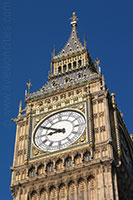
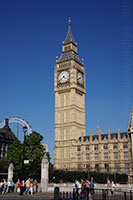
Parliament Square
The hour bell was probably named after Benjamin Hall, the First Commissioner of Works. Some sources however claim the bell was named after Benjamin Caunt, a British heavyweight boxing champion.
The Clock
The clock is known for its reliability, it has rarely failed during its long life span. Even after the nearby House of Commons was destroyed by bombing during World War II, the clock kept on chiming. The clock’s mechanism, designed by Edmund Beckett Denison, has a remarkable accuracy. The clock’s rate is adjusted by simply adding small pennies on the shoulder of the pendulum.
The Tower
The clock tower rises 316ft high (96m) and consists of a 200ft (61m) high brick shaft topped by a cast iron framed spire. The clock faces are 180ft / 55m above ground level.
Views
The London Eye
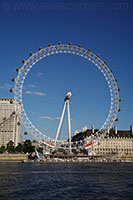
A Landmark for the new Millennium
They submitted their idea for a large observation wheel as part of a competition to design a landmark for the new millennium.None of the entrants won the competition, but the couple pressed on and eventually got the backing of British Airways, who sponsored the project.
Construction
Construction of the observation wheel took more than a year and a half to complete. In the process over 1700 tonnes of steel were used for the structure and more than 3000 tonnes of concrete were used for the foundations.
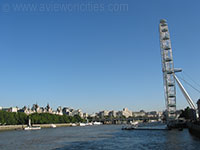
The futuristic looking capsules, accommodating up to 25 passengers, were transported all the way from France by train through the chunnel. Each egg-shaped capsule is 8 meters long and weighs 500kg. The 25 meter (82 ft) long spindle was built in the Czech Republic. The rim has a diameter of 122m (400ft), about 200 times the size of a bicycle wheel. 80 Spokes connect the rim with the spindle.
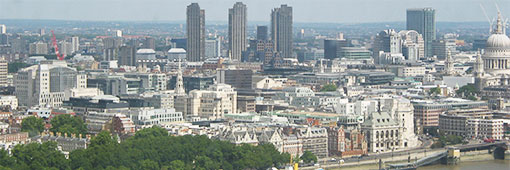
The Observation Wheel
The observation wheel turns slow enough for people to embark while it is moving. A complete turn takes about 30 minutes. Thanks to the construction of the glass capsules on the outer side of the rim,
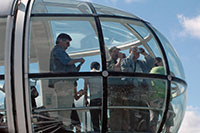
the passengers have a great 360° view over London. Many famous landmarks are clearly visible, including Buckingham Palace, St. Paul’s Cathedral and the Houses of Parliament. On a clear day you can see as far as 40 km (25 miles).
Make sure you get your tickets in advance, lines can be very long, both the lines for embarking and for ticket purchases. It’s less crowded at night when the views are even more spectacular.
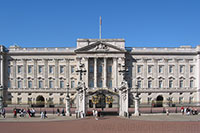
History
The original building was constructed as a countryhouse in 1705 by the duke of Buckingham, John Sheffield. King George III bought the house in 1761 for his wife and had it altered by William Chambers.
In 1826, King George IV asked famed architect John Nash to expand the house – then known as Buckingham House – into a palace. Meanwhile St. James’s Palace was still the principal palace used by the royals for ceremonies and receptions.
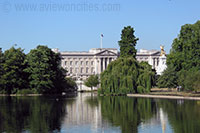
St. James’s Park
King George IV as well as his younger brother and successor King William IV both died before the palace was completed. Queen Victoria was the first to reside in the palace. In July 1837, three weeks after her accession to the throne, she moved from Kensington Palace, where she grew up, to the new Buckingham Palace.
The palace was expanded in 1850 with a new east wing. The wing added a large number of rooms to the palace, including an expansive 40 meter (131 ft) long ballroom. The monumental façade of the east wing was built in 1913 by Aston Webb. It is this facade, facing the Mall and St James’s Park, which is now known by most people.
A part of the palace is still used by the Royal family. A flag is hoisted each time the Queen is in the Palace. The palace is not only home to the royal family, there are also a number of staff members living here. The palace has about 600 rooms, including a throne room, a ballroom, picture gallery and even a swimming pool.
Some of these rooms can be visited during a couple of months in the summer – when the Royal Family is not in the palace – including the lavishly decorated State Rooms: the Throne Room, Green Drawing Room, Silk Tapestry Rooms, Picture Gallery, State Dining Room, Blue Drawing Room, Music Room and White Drawing Room are all part of the tour around the Buckingham Palace.
Another interesting part of the palace that is open to visitors is the Queen’s Gallery, where works of art from the royal collection are on display. The palace’s stables, the Royal Mews, can also be visited. Here you’ll find a number of royal horse-drawn carriages.
Right in front of the building is the Queen Victoria Memorial,
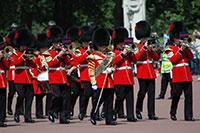
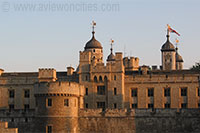
Construction of the Tower of London was initiated in 1070 by William the Conqueror, shortly after his victory at Hastings in 1066. The Tower was built to enforce the power of the king over the newly conquered region.
The fortress, strategically located at the Thames, was originally not more than a temporary wooden building which was replaced later by the White Tower. Over time the complex was expanded into a stronghold with about 20 towers.
Today the Tower of London is best known for its Crown Jewels, but it used to be notorious for the many political opponents of the kings that were locked, tortured and killed in the Tower. The Tower was also a royal residence: several kings lived here, especially during turbulent times when the donjon seemed a lot safer than the palace in Westminster.
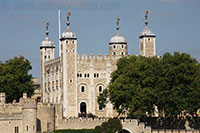
The oldest part of the fortress is the so-called White Tower, which was completed in 1097. This keep was long the tallest building in London at 27.4 meters (90ft). Its walls are 4.6 meter wide.
The tower was whitewashed during the reign of Henry III, which gave the tower’s facade its white appearance. Ever since the tower has been known as White Tower. The building has four domed turrets at each corner. Three of them have a square shape, the other is round, due to its spiral staircase. The round turret was long used as an observatory.
The Tower of London was significantly expanded in the 13th century, during the reign of Henry III, when two defensive walls were built around the White Tower. The inner wall had thirteen towers and the outer wall another six. The towers were mostly used to imprison political opponents.
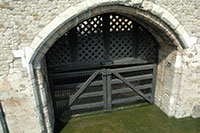
Some of the most famous prisoners locked in the Tower were two princes, the sons of king Edward IV. After Edward’s dead in 1483 the children were locked in the Bloody Tower by their uncle, who would later ascend the throne as king Richard III. The princes were never seen again and were probably killed by guards.
The St. Thomas Tower is located close to the Bloody Tower. Here, prisoners were brought into the fortress by boat through the Traitor’s gate.
Important prisoners were often locked in the Beauchamp Tower, sometimes with their servants. An inscription on the wall of the tower is believed to refer to Lady Jane Grey, who, nine days after she was crowned Queen, was executed on Tower Green, an open terrain in the Tower of London.
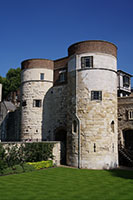
Thomas More was imprisoned in the Bell Tower until his execution after he refused to accept king Henry VIII as head of the Anglican church. Even Queen Elisabeth I was confined here for some time.
Dressed in historic clothes, they not only guard the tower, but also give guided tours of the fortress. One of the about 40 Yeoman Warders is known as the Ravenmaster, responsible for the ravens that have been living here for centuries.
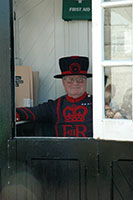
Legend has it that the Tower and the kingdom will fall if the ravens leave. Hence King Charles II placed the birds under royal protection and the wings of the ravens are clipped to prevent them from flying away.
The most famous tourist attraction in the Tower of London is the collection of Crown Jewels that has been on display here since the 17th century, during the reign of Charles II. Most of the jewels were created around the year 1660, when the monarchy was reinstalled. The majority of the older crown jewels were destroyed by Oliver Cromwell.
The jewels can be found in the Jewel House, which is part of the Waterloo Barracks just north of the White Tower. Some of the highlights of the collection are the 530 carat First Star of Africa, which is set in the
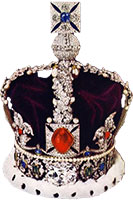
Scepter of the Cross; the Imperial State Crown with more than 2800 diamonds and the famous Koh-I-Noor, a 105 carat diamond.
There’s plenty more to see in the Tower of London, such as the Royal Armories, which includes the personal armory of King Henry VIII, one of the world’s largest.
The medieval palace in the Tower of London is also open to visitors and there are often reenactments of historic events in the fortress. For more information on the highlights of the Tower of London, check out their excellent and exhaustive website.
A colorfully dressed detachment, known as the New Guard, parades along the Mall towards Buckingham Palace and during a ceremony replaces the existing, Old Guard. The ceremony, which is accompanied by music played by a military band, always attracts throngs of onlookers.
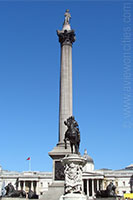
History
From the 13th century on the area was the site of the King’s Royal Hawks and later the Royal Mews. In 1812 the Prince Regent – who would later become King George IV – asked architect John Nash to redevelop the area. Nash had the terrain cleared but he died before his plans were realized. The new design for a large square was finally implemented between 1840 and 1845 under supervision of architect Sir Charles Barry, who is best known for
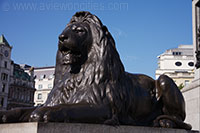
his Houses of Parliament.
Nelson’s Column
At the center of the square is the tall Nelson’s Column which was built to commemorate the victory of Admiral Horatio Lord Nelson over the French fleet at the Battle of Trafalgar on the 21st of October 1805. Nelson was fatally wounded during that famous battle off the Spanish coast. His body was taken back to London and buried in the St. Paul’s Cathedral.
The Corinthian column was built in 1842 and is approximately 170ft or 52 meters high (including the base). It was built after a design by William Railton that was chosen from a selection of 124 competition entries. On top of the column stands an 18ft (5.5 meter) tall statue of Lord Nelson, created by Edmund Hodges. At the base of the
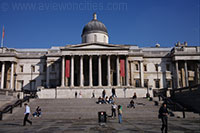
column are four huge lions modeled by Sir Edwin Landseer. They were added later, in 1868.
National Gallery
Trafalgar square also contains a large number of statues and two fountains by Sir Edwin Lutyens, added in 1939. The square is surrounded by many great buildings. On the north side is the neo-classical National Gallery, built between 1834 and 1838. It houses a collection of more than 2300 paintings, including works by van Gogh, Renoir, Leonardo da Vinci and Claude Monet. On the east side the square is bordered by the Canada House,
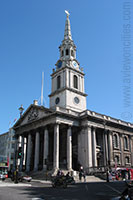
completed in 1827. Opposite the Canada House is the South Africa House, which opened in 1933.
St. Martin-in-the-Fields
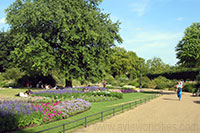
The other parks are the neighboringKensington Gardens, Green Park and St. James’s Park. Hyde park covers more than 360 acres (142 hectares) and hosts many large events, including celebrations and concerts. It is also a popular place for jogging, swimming, rowing, picnicking and even horse riding.
History
In 1536 King Henry VIII confiscated Hyde Park from the monks ofWestminster Abbey. It was used primarily for hunting. King Charles I opened the park to the public in 1637. The current park
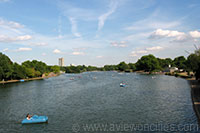
layout was planned by architect Decimus Burton in 1825.
Serpentine
Diana, Princess of Wales Memorial Fountain
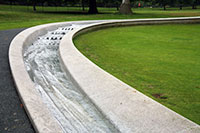
Just southwest of the Serpentine is a memorial installed in honor of princess Diana. The modern fountain, which more resembles an artificial stream rather than a fountain, was inaugurated in 2004 by Queen Elisabeth II.
The memorial was designed by the American landscape architect Kathryn Gustafson, using computer modeling techniques. The circular fountain consists of 545 pieces of Cornish granite. Water flows from two sides at the top into a small pool at the bottom.
At the south end of Hyde park is Rotten Row, a famous bridle path. The road is almost four miles long (6,4 km) and is now used as a horse riding, cycling, rollerblading and jogging route.
In the 17th century the road was often used by William III. The king found the walk from Kensington Palace to St. James’s Palace too dangerous, so he had oil lamps installed along the route, thus
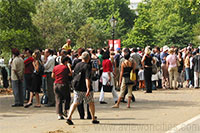
creating the first lit public road in England. The term ‘Rotten Row’ is derived from the French ‘route du roi’ or King’s road.
Speaker’s Corner
In the 19th century Hyde Park had become a popular place for meetings. In 1872, in response to riots after police tried to disband a political meeting, Speaker’s Corner was established to create a venue where people would be allowed to speak freely. Here, every Sunday people stand on a soap box and proclaim their views on political, religious or other items, sometimes
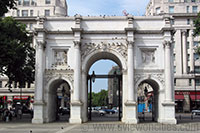
interrupted and challenged by their audience.
Marble Arch
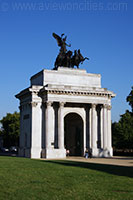
Wellington Arch
Another arch, the Wellington Arch, can be found on Hyde Park Corner, at the south-east corner of the park, connecting Hyde Park with Green Park. The arch was built in 1826 by Decimus Burton.
A statue of the Duke of Wellington was added later, in 1846. The statue was replaced by the Quadriga
The Museum Building
The Smirke Building
The idea for the Smirke Building, designed by Sir Robert Smirke in Greek revival style, was conceived in 1823 but the addition was not completed until nearly 30 years later.
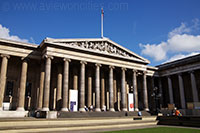
It was originally built to house the personal library of King George III. This new building was a quadrangle situated north of the Montague House. The south wing of the Smirke Building eventually replaced the old house.
Parthenon Galleries
The Parthenon Galleries, by American John Russell Pope, was built to house the Parthenon sculptures and opened in 1939. However, because of extensive damage suffered during World War II, the
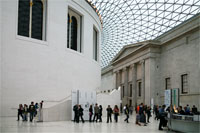
structure had to be rebuilt and was reopened in 1962. Another new wing, opened in 1980, housed public facilities like a restaurant and gift shop.
The Great Court
Finally, the Queen Elizabeth II Great Court opened in 2000. This two-acre square (8000 sq m), enclosed by a glass roof, creates an indoor courtyard with the museum’s famed circular reading room in the center. This design made by Norman Foster and Partners makes it easier for visitors to find their way in the museum thanks to the large open space, very similar to the way the
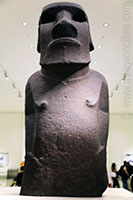
entrance area below the Louvre Pyramid in Paris works.
The Museum’s Collection
Elgin Marbles

The sculptures, also known as the Parthenon Marbles, were obtained by Thomas Bruce, the 7th Earl of Elgin and diplomat in Constantinopal in the Ottoman Empire, which at that time included Greece.
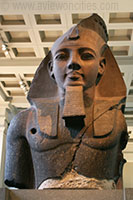
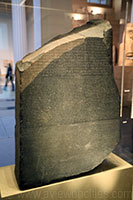
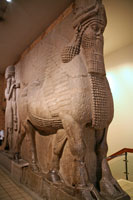
Earl Elgin obtained permission “to take away any pieces of stone with old inscriptions or figures thereon”, to prevent any more damage by the Turkish.
Lord Elgin’s collection was at first displayed at his own house, but in 1816 the House of Commons decided to purchase the collection and hand it over to the British Museum.
Egyptian Collection
The text on the stone, created in 196 BC after the end of the Egyptian dynasties, is written in three different writings: Greek, hieroglyphic and demotic (a symplified form of hieroglyphic).
The British Museum is also known for its very large and popular collection of Egyptian mummies and coffins. You can even find animal mummies here.
Assyrian collection
Other departments
Υπεύθυνη Εκπαιδευτικός: Κεφαλοπούλου Γεωργία
Αγγλικής Γλώσσας ΠΕ06

